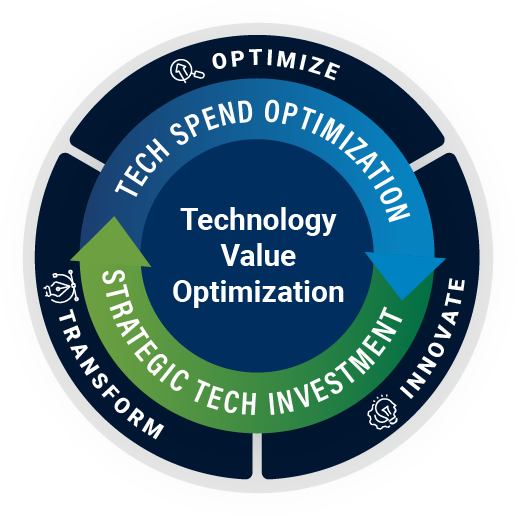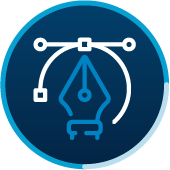Technology Value Optimization: A Strategic Program, not a Cost-Cutting Exercise
Published on May 7, 2024
Michael Kleinmann | Managing Director
Key Takeaway
Embracing a strategic approach to technology value optimization, with a focus on aligning IT investments, driving innovation, and enabling transformation, is crucial for health systems to navigate financial challenges and drive meaningful improvements in patient care, operational efficiency, and financial performance.
- Technology value optimization is a strategic approach that aligns IT investments with business goals, maximizes value from existing systems, and drives innovation and transformation.
- To ensure success, health systems should focus on establishing metrics and key performance indicators (KPIs), implementing robust governance and prioritization, and embedding continuous improvement practices.
- Health systems should adopt an “optimize, innovate, and transform” approach by aligning IT priorities, fostering innovation, and advancing digital transformation initiatives.
Much has been written about the current financial condition of health care and the plight of health systems across the country. The financial outlook among industry ratings agencies in 2024 have generally ranged between gloomy to stabilizing. At Edera, we believe that while vigilance is necessary, there is reason for hope – and technology will play a critical role in helping health systems navigate the challenges ahead.
It is well understood at this point and, as discussed in earlier posts about health care realities and system archetypes, technology is deeply embedded in every aspect of care delivery. Whether an organization is a Pioneer, Pathfinder, Pursuer, or Preserver, maximizing the value of technology investments must be a top strategic priority.
Responding to this call requires a balanced approach to optimizing technology spend, while identifying opportunities to invest in business-led, technology-enabled innovation and transformation initiatives. The goal is to free resources, solidifying your foundation and self-funding your transformation. To achieve this, technology leaders must explore every avenue to manage spend smartly and creatively. Certainly, this isn’t new, but many IT organizations have not had the resources for this strategy in the past. Mounting demands and constrained budgets make it essential.
Some health systems may feel pressure to simply cut costs and “get to benchmark.” But while benchmarks can be useful, they are not sufficient in isolation. This is especially true when considering that competitors come in many forms, business models are evolving rapidly, consumer expectations are rising, and technology itself is advancing at unprecedented speed. Simultaneously, cyber threats grow more sophisticated by the day. Given these realities, many health systems anticipate the need to spend more, not less, on technology. The key is to think differently about where and how those investments are made. This shift in mindset, by definition, makes technology value optimization highly strategic — it should be treated as such by health system leaders.
This is the core of ‘technology value optimization’ – a strategic approach and mindset that emphasizes:

- Aligning IT with business and clinical ambitions and objectives
- Maximizing value from existing systems
- Creating efficiencies among resources
- Leveraging partnerships to co-create, build, and deliver
- Reallocating resources for transformation
- Strategically investing in existing and new capabilities that foster innovation
The goal of technology value optimization is not short-term cost cutting, rather positioning IT as a collaborative and forward-thinking partner that drives optimization, innovation, and transformation for the organization.
Why is this “optimize, innovate, and transform” approach important? Research has shown that organizations that are further along the digital transformation journey are more profitable than those lagging behind. Studies have also demonstrated a significant return on investment (ROI) for strategic AI investments. As noted in our Health Systems and the Four Archetypes piece, each organization finds itself at a different starting point. Thus, the path will look different for each health system based on their services, markets, financial situation, and strategic imperatives; however, the approach will be similar.
A Synchronized Strategy: Optimize, Innovate, and Transform

Optimize.
An essential part of optimization involves aligning IT with your business, clinical, and operational stakeholders to ensure that priorities and investments are in lockstep with the organization’s strategic objectives. Start by conducting a comprehensive evaluation of your current technology posture, focusing on four main areas: strategy and operations, applications and data, infrastructure, and security. At the same time, establish and adhere to a set of guiding principles to govern identification of opportunities and extract greater value from existing technology investments. This often includes boosting the adoption of solutions you already own, streamlining your application portfolio to minimize redundancy and complexity, or exploring ways to better leverage your core platforms.
One example is virtual care. After providers rushed to move to virtual, many health systems found themselves owning multiple solutions with varying degrees of connectivity with their electronic health record (EHR) and suboptimized workflows. Moving to a single, virtual care solution can be a challenge, but will ultimately standardize experiences, streamline data integration, and reduce costs. By pursuing the right mix of optimization tactics, not only can you find ways to judiciously reduce costs, but you can also redirect those savings toward other high-priority, business-aligned initiatives that deliver greater value to the organization.
Actions to Optimize
- Conduct a Technology Audit: Review current technology investments, contracts, and usage to identify areas of inefficiency or redundancy.
- Leverage Data Analytics: Utilize enterprise data and analytics to make informed decisions about where optimizations can be most effective.
- Rationalize Applications: Assess the application portfolio for opportunities to consolidate and retire legacy systems that are costly to maintain.
- Maximize Core Platforms: Take advantage of funded, but unused platform functionality and identify opportunities to modernize core platforms to keep pace with business and clinical needs.
- Optimize Cloud Usage: Migrate applications and storage to the cloud where practical, monitor consumption levels to balance cost savings with security, performance, and engineering productivity, and manage cost allocation.
- Streamline Vendor Management: Negotiate with vendors for better rates, consider alternate vendors for cost-effective solutions, and manage contracts to prevent unnecessary expenditures.
- Implement IT Financial Management Practices: Adopt IT financial management practices that align costs to services and outcomes to ensure that IT spending is transparent and accountable.
- Foster Cross-Functional Collaboration: Collaborate with clinical and administrative stakeholders to ensure that technology spend is aligned with hospital priorities and patient care objectives.
- Adopt Lean IT Principles: Introduce process improvements and eliminate waste in IT operations to achieve more with less.

Innovate.
Embracing a culture of innovation starts with empowering your workforce to think creatively, share ideas freely, and acquire new skills and capabilities. Look for opportunities to invest in targeted AI and automation initiatives that can streamline operations, reduce human error, and allow staff to focus on higher-value work. The EHR can serve as a powerful platform for innovation — explore ways to leverage your EHR system to support clinical decision-making, derive new insights, and improve care coordination, value-based care delivery, and population health management.
Consider piloting emerging technologies like telemedicine, remote monitoring, precision health applications, and digital therapeutics in a limited scope to assess their impact and potential before pursuing wider adoption. Avoid investing in complicated solutions no one asked for by making sure a sound business case exits that is sponsored outside of IT. Developing strategic partnerships with technology firms, consultancies, and other organizations can accelerate and de-risk innovation by enabling co-development of cutting-edge solutions, enhancing performance, expanding capabilities, differentiating your organization in the market, and providing cost-sharing opportunities.
Actions to Innovate
- Cultivate a Culture of Innovation: Create a culture that encourages innovative thinking and the sharing of ideas across the organization and upskill workforce capabilities.
- Embrace AI and Automation: Invest in business-aligned AI integration and automation to streamline operations, reduce errors, and free up staff for higher-value work.
- Leverage Platforms for Innovation: Use existing technology platforms, particularly the EHR, as a foundation for innovation by exploring ways to extend functionality, integrate with third-party solutions, and develop applications that enhance clinical workflows, patient engagement, and data analytics capabilities, ultimately driving meaningful improvements in care delivery, efficiency, and outcomes.
- Support Clinical Decision-Making: Advance systems that provide actionable insights to clinicians, improving the quality of care and patient outcomes, especially in support of comprehensive care coordination, value-based care, and population health.
- Invest in Digital Health Initiatives: Explore telemedicine, remote monitoring, and mobile health applications to extend the reach of patient care.
- Pilot New Technologies: Implement pilot programs with strategic use cases for emerging technologies, such as precision health and digital therapeutics, evaluating their impact before wide-scale deployment.
- Develop Strategic Relationships: Foster strategic partnerships and alliances with technology companies, consulting and process management firms, and other organizations to co-develop solutions and capabilities that improve performance, extend capabilities, create market differentiation, and off-set costs.

Transform.
The threat landscape continues to evolve, so staying ahead of cybersecurity risks is paramount. Ensure you are proactively implementing robust security controls, technologies, and practices to safeguard sensitive data and critical systems. As you pursue digital transformation, do not overlook the importance of enabling your workforce with the tools, skills, and training needed to adapt to new technologies and ways of working.
Partner closely with clinical and business leaders to build an aligned roadmap of initiatives that will drive the organization’s digital transformation, with a focus on meaningfully improving patient experience and operational efficiency. Look for opportunities to fundamentally reimagine how care is delivered, leveraging technology to enable new care models like remote monitoring, hospital-at-home, and precision health. Wherever possible, break down silos by integrating systems and data across the care continuum to enable seamless information flow. Consider establishing an ‘Integration Enablement Center’ to centralize and streamline system integrations using standardized solutions, improving efficiency, reuse, speed, and cost.
Actions to Transform
- Advance Cybersecurity Measures: Implement robust cybersecurity measures to protect patient data and hospital operations from increasing cyber threats.
- Support Workforce Enablement: Provide technology tools and training that enable the workforce to adapt to new ways of working.
- Partner for Digital Transformation: Partner with the business and clinical functions to develop an aligned initiative portfolio to drive the organization’s digital transformation, focusing on improving patient experience and operational efficiency.
- Adopt New Care Delivery Models: Utilize technology to support new models of care, such as remote care and precision health, fundamentally changing how care is delivered.
- Create an Enablement Center: Create an integration enablement center that streamlines enterprise-wide system integration efforts into one operating model with standardized solutions and capabilities for improved efficiency, increased speed and reusability, and lower costs.
- Integrate Systems Across the Care Continuum: Ensure interoperability between different systems and data sources to provide a seamless flow of information.
Planning for Success
As health systems plan their technology value optimization program, they should consider three overarching elements that are necessary for alignment and long-term success: metrics and KPIs, governance and prioritization, and continuous improvement.
Governance and Prioritization
A robust governance framework and prioritization process is essential to ensure that technology investments align with business objectives and deliver maximum value. This involves establishing clear decision-making criteria, roles and responsibilities, and processes for evaluating, selecting, and managing technology projects. Leading practices include:
- Establishing a cross-functional steering committee to provide oversight and ensure alignment between IT and business stakeholders
- Implementing a project portfolio management approach to prioritize initiatives, based on strategic alignment, ROI, and resource capacity
- Institutionalizing the use of business cases, voice-of-the-customer analyses, and assignment of clinical/business sponsors for business-enabling technology investment requests
- Conducting regular ROI analyses to assess the financial and non-financial benefits of technology investments
- Implementing a stage-gate process to evaluate and approve projects at key milestones
- Regularly reviewing and adjusting the project portfolio based on changing business needs and technology trends
By implementing effective governance and prioritization practices, health systems can ensure that their technology investments are focused on the highest-value opportunities and are delivered in a coordinated and efficient manner.
Continuous Improvement
Technology value optimization should not be viewed as a one-time event, but rather an ongoing effort with built-in processes for monitoring, evaluating, and improving technology investments to ensure they continue to deliver value over time. This requires a durable infrastructure, a culture of continuous improvement, and a willingness to adapt to changing business needs and technology trends. Key strategies for continuous improvement include:
- Regularly collecting and analyzing user feedback to identify areas for improvement and inform future technology investments
- Establishing performance metrics and dashboards to monitor the ongoing effectiveness and efficiency of technology solutions
- Conducting regular technology audits and assessments to identify opportunities for optimization and innovation
- Implementing agile development and delivery methodologies to quickly iterate and improve technology solutions, based on user feedback and changing requirements
- Fostering a culture of experimentation and learning, where teams are encouraged to try new approaches and learn from failures
By embedding continuous improvement practices into technology value optimization efforts, health systems can ensure that technology investments remain aligned with business objectives and continue to deliver value over the long term.
Parting Thoughts
The road ahead for health systems is complex and filled with challenges, but by embracing a technology value optimization approach IT leaders can position their organizations for success. By aligning with business objectives, optimizing existing investments, fostering innovation, and enabling transformation, IT can drive meaningful improvements in patient care, operational efficiency, and financial performance. While the specific actions each organization takes will depend on their unique starting point and goals, the core principles of technology value optimization provide a roadmap for navigating an uncertain landscape. With a strategic, collaborative, and adaptive mindset, health system IT leaders can not only weather the current storm, they can position IT as a true value center and emerge as a catalyst for positive change and growth in the years to come.
Frequently Asked Questions
What are some common challenges in implementing a technology value optimization program?
Some common challenges include resistance to change from staff and stakeholders, lack of clear ownership and accountability, difficulty in measuring and demonstrating ROI, and competing priorities and resource constraints. To mitigate these challenges, focus on change management and communication, establish clear roles and governance structures, define measurable success criteria, and prioritize initiatives based on strategic alignment and impact.
How can I balance the need for cost optimization with the demand for new technology investments?
To balance cost optimization and new investments, take a portfolio management approach. Evaluate each initiative based on its strategic alignment, expected benefits, and resource requirements, and prioritize those that deliver the greatest value. Look for opportunities to self-fund new investments through cost savings from optimization efforts. Consider alternative funding models, such as partnerships, leasing, or pay-per-use, to reduce upfront costs and risk.
How do I ensure that technology value optimization efforts are sustainable over time?
To ensure sustainability, embed technology value optimization into the organization’s culture and processes. Establish a dedicated team or function responsible for ongoing value optimization efforts and provide them with the necessary resources and support. Implement regular review and adjustment processes to ensure that initiatives remain aligned with changing business needs and technology trends.

